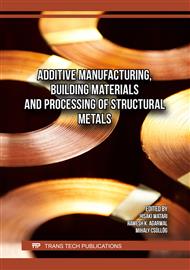[1]
D. Godec, J. Gonzalez-Gutierrez, A. Nordin, E. Pei, and J. Ureña, A Guide to Additive Manufacturing, Cham, Switzerland, Springer, 2022.
DOI: 10.1007/978-3-031-05863-9
Google Scholar
[2]
T. Wohlers, and T. Gornet, "History of additive manufacturing. Wohlers Report," History of Additive Manufacturing; Wohlers Associates, Inc.: Fort Collins, CO, USA, 2014.
DOI: 10.31399/asm.hb.v24.a0006548
Google Scholar
[3]
W. Oropallo, and L. A. Piegl, "Ten challenges in 3D printing," Engineering with Computers, vol. 32, no. 1, pp.135-148, 2015.
DOI: 10.1007/s00366-015-0407-0
Google Scholar
[4]
N. Li, Y. Li, and S. Liu, "Rapid prototyping of continuous carbon fiber reinforced polylactic acid composites by 3D printing," Journal of Materials Processing Technology, vol. 238, pp.218-225, 2016/12/01/, 2016.
DOI: 10.1016/j.jmatprotec.2016.07.025
Google Scholar
[5]
Chang Jiang, "Tree-shaped support structure generation for 3D printing by deep reinforcement learning," Korea, Seoul National University, 2021.
Google Scholar
[6]
M. Shirmohammadi, S. J. Goushchi, and P. M. Keshtiban, "Optimization of 3D printing process parameters to minimize surface roughness with hybrid artificial neural network model and particle swarm algorithm," Progress in Additive Manufacturing, vol. 6, no. 2, pp.199-215, 2021/05/01, 2021.
DOI: 10.1007/s40964-021-00166-6
Google Scholar
[7]
K. V. Wong, and A. Hernandez, "A Review of Additive Manufacturing," ISRN Mechanical Engineering, vol. 2012, pp.1-10, 2012.
Google Scholar
[8]
N. Jeyaprakash, M. M. Cheepu, and C.-H. Yang, Advances in Additive Manufacturing Processes, Oklahoma,Bentham Science Publishers, (2021)
Google Scholar
[9]
Z.-X. Low, Y. T. Chua, B. M. Ray, D. Mattia, I. S. Metcalfe, and D. A. Patterson, "Perspective on 3D printing of separation membranes and comparison to related unconventional fabrication techniques," Journal of Membrane Science, vol. 523, pp.596-613, 2017.
DOI: 10.1016/j.memsci.2016.10.006
Google Scholar
[10]
M. Mohri, A. Rostamizadeh, and A. Talwalkar, Foundations of Machine Learning: The MIT Press, 2018.
Google Scholar
[11]
S. Shalev-Shwartz, and S. Ben-David, Understanding Machine Learning: From Theory to Algorithms: Cambridge University Press, 2014.
DOI: 10.1017/cbo9781107298019
Google Scholar
[12]
T. Jiang, J. L. Gradus, and A. J. Rosellini, "Supervised Machine Learning: A Brief Primer," Behavior Therapy, vol. 51, no. 5, pp.675-687, 2020/09/01/, 2020.
DOI: 10.1016/j.beth.2020.05.002
Google Scholar
[13]
D. W. T. H. R. T. Gareth James, An introduction to statistical learning : with applications in R: New York : Springer, [2013] ©2013, 2013.
Google Scholar
[14]
O. O. Aremu, D. Hyland-Wood, and P. R. McAree, "A machine learning approach to circumventing the curse of dimensionality in discontinuous time series machine data," Reliability Engineering & System Safety, vol. 195, p.106706, 2020/03/01/, 2020.
DOI: 10.1016/j.ress.2019.106706
Google Scholar
[15]
A. Bhrigu, K. Michael, and S. Michael, 2015, "Additive manufacturing in production: challenges and opportunities.", available: https://www.researchgate.net/publication/301366969_Additive_manufacturing_in_production_challenges_and_opportunities.
Google Scholar
[16]
O. Abdulhameed, A. Al-Ahmari, W. Ameen, and S. H. Mian, "Additive manufacturing: Challenges, trends, and applications," Advances in Mechanical Engineering, vol. 11, no. 2, p.1687814018822880, 2019.
DOI: 10.1177/1687814018822880
Google Scholar
[17]
N. A. Sbrugnera Sotomayor, F. Caiazzo, and V. Alfieri, "Enhancing Design for Additive Manufacturing Workflow: Optimization, Design and Simulation Tools," Applied Sciences, vol. 11, no. 14, p.6628, 2021.
DOI: 10.3390/app11146628
Google Scholar
[18]
B. Bebeshko, K. Khorolska, N. Kotenko, A. Desiatko, K. Sauanova, S. Sagyndykova, and D. Tyshchenko, "3D modelling by means of artificial intelligence," Journal of Theoretical and Applied Information Technology, vol. 99, no. 6, pp.1296-1308, 2021.
Google Scholar
[19]
T. Liu, L. Huang, and B. Chen, "Real-time defect detection of laser additive manufacturing based on support vector machine," Journal of Physics: Conference Series, vol. 1213, no. 5, p.052043, 2019/06/01, 2019.
DOI: 10.1088/1742-6596/1213/5/052043
Google Scholar
[20]
S. Ford, and M. Despeisse, "Additive manufacturing and sustainability: an exploratory study of the advantages and challenges," Journal of Cleaner Production, vol. 137, pp.1573-1587, 2016/11/20/, 2016.
DOI: 10.1016/j.jclepro.2016.04.150
Google Scholar



